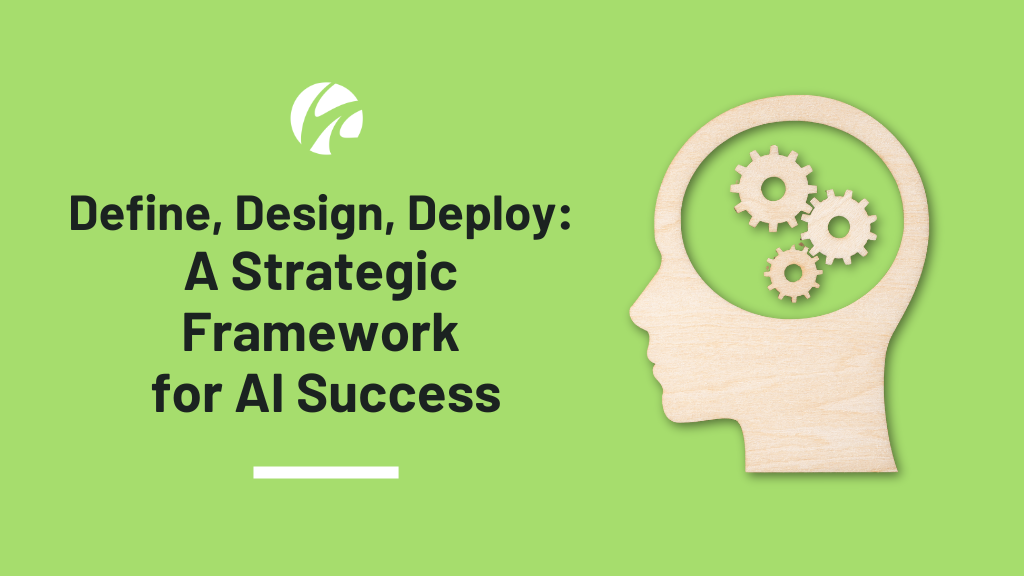4 min read
Define, Design, Deploy: A Strategic Framework for AI Success in CPA Firms
For managing partners, the AI question is no longer “if” but “how”—how to turn investment into measurable value without disrupting firm culture. In...

Brian is a seasoned CPA firm leader and strategist with decades of experience driving transformation across professional services. A former Chief Growth Officer at Wipfli, he now advises firms and PE groups on leadership alignment, M&A integration, and sustainable, people-first strategy.
Table of Contents
.png?width=1024&height=576&name=Building%20an%20%20AI%20Use%20Case%20Roadmap%20(1).png)
Generative AI is no longer theoretical: it’s already reshaping the accounting profession. Tax software vendors are embedding AI copilots, Big 4 firms are piloting large-scale automation, and clients are walking into meetings with ChatGPT-drafted memos. Yet many firm leaders remain overwhelmed by the sheer volume of possibilities. Without a systematic way to evaluate and prioritize AI opportunities, firms either chase every new tool or postpone action until “the landscape becomes clearer.”
Neither approach works. Your firm’s AI-native competitors aren’t waiting for clarity; rather, they’re already redefining client expectations and service delivery models. Firms that act decisively now can build sustainable advantages, while those that delay risk losing business to more technologically sophisticated competitors.
The solution lies in developing an AI use case roadmap: a structured framework that transforms overwhelming possibilities into clear priorities and actionable plans.
Across the profession, AI has shifted from deploying pilot projects to everyday application. Firms are using advanced systems to perform reasoning tasks, manage multi-step workflows, and support client delivery with less direct oversight. What once felt experimental is now embedded in production environments, shaping how real client work gets done.
The vendor landscape reflects this acceleration. Legacy technology solutions are pivoting their offerings toward comprehensive AI platforms, while specialized startups are focusing on bespoke tasks such as document review, financial analysis, client communication, workflow optimization, and more. Firms must navigate between building internal capabilities and integrating external solutions, and what’s more; in many instances, they need to build the plane as they’re flying it.
But here's what many leaders miss: successful AI adoption isn't primarily about technology selection. It requires rethinking how work gets done, updating quality control procedures, retraining staff, and often restructuring service delivery models entirely, and treating AI transformation as a strategic business initiative, not a technological project.
Too many firms are approaching AI adoption in predictably unsuccessful ways. Some suffer from ‘shiny object syndrome’, lurching from tool to tool, which are often addressing isolated use cases, without considering the impact to adjacent processes and workflows and alternatives. Others become overwhelmed by possibilities and wait on the sidelines as their competitors innovate and capture market share.
A systematic use case roadmap prevents both traps by providing three essential elements:
Without this structure, firms waste time and money on disconnected initiatives that don't build toward larger strategic objectives. A roadmap ties every experiment to a broader plan, ensuring that investments compound over time. Firms that apply this discipline not only avoid costly missteps but also position themselves to scale AI adoption faster and with greater confidence than their competitors.
Our core tool for AI strategic planning is the AI Use Case Prioritization Matrix: a visual framework that plots potential initiatives based on their business impact and implementation complexity. This approach moves decision-making beyond gut instinct toward data-informed resource allocation.
Below is a sample Matrix created for the use of AI in a regional accounting firm’s tax practice.

The vertical axis measures business impact across multiple dimensions: time savings per engagement, cost reduction potential, revenue opportunities from new services, and improvements to client experience. The horizontal axis assesses implementation difficulty, considering technical complexity, data preparation requirements, staff training needs, and integration challenges with existing systems.
High-impact, low-complexity initiatives occupy the upper-left quadrant and are considered ‘Quick Wins’: immediate opportunities that represent low-hanging fruit. Projects in the lower-right quadrant, which we term ‘Resource Drains’, should typically be avoided or delayed significantly until the technology evolves further. The other quadrants require judgment calls based on your firm's risk tolerance, available resources, and strategic timeline. Opportunities in the top-right ‘Strategic Initiatives’ quadrant yield the biggest reward but higher levels of implementation difficulty, while those in the lower-left ‘Incremental Improvements’ quadrant offer smaller process improvements that are relatively straightforward to implement.
Instead of trying to apply this model across your entire firm, we recommend focusing on specific horizontal business units, i.e. service lines (Audit, Tax, Advisory), or business functions (Sales and Marketing, HR, Finance, Compliance/Risk), or Industry Verticals. Under each of these will be internal and external use cases. Accurately evaluating opportunities requires both a 30,000 foot view from the leadership level and the technical, soup to nuts understanding of how the business unit actually functions.
For each use case that you identify, estimate the specific value a successful implementation would unlock. Instead of vague "efficiency gains," quantify the actual impact: how many hours could this save per engagement? What percentage of routine tasks could be eliminated? How many client touchpoints could be streamlined? Be as specific as your current data allows, but don't let imperfect information prevent evaluation.
Next, assess implementation requirements realistically. Do initiatives demand new software platforms, custom development, or complex integrations with existing systems? How much staff retraining and change management is required? What new quality control procedures must be developed? What's the realistic timeline from decision to full deployment?
Plot each use case on your matrix. The visual representation reveals patterns and trade-offs that aren't always obvious in more abstract analysis.
A prioritization matrix is a valuable framework, but it's only the starting point for a much more comprehensive solution. Converting the strategic insights captured in the matrix into operational reality demands that leaders translate abstract priorities into concrete initiatives with timelines, resources, and measurable outcomes.
Choose one or two use cases from your high-priority quadrant for immediate implementation. Resist the urge to tackle everything simultaneously. AI adoption requires focused attention to succeed. Your initial selections should balance potential impact with your organization's capacity for change.
Consider starting with use cases that build on existing technology investments or data you already collect systematically. These projects encounter fewer obstacles and deliver results faster than initiatives requiring entirely new systems.
Establish specific, measurable outcomes for each initiative. "Improved efficiency" isn't a success metric—"25% reduction in time spent on Schedule K-1 preparation" is.
Success metrics serve multiple purposes: they justify continued investment, inform refinements to your approach, and provide concrete evidence of the transformative impact of these initiatives when communicating results to skeptical partners or staff members.
Organize your roadmap into three distinct phases:
While this framework provides a solid strategic foundation, it represents only the beginning of your AI journey. The further you progress, the more important it becomes to add additional layers of discipline that ensure AI is not only effective, but also sustainable, secure, and trusted.
Four areas in particular deserve early recognition:
These elements don’t need to dominate your first wave of projects—but they should be on your radar. By treating them as “future readiness layers,” you’ll build an AI program that not only generates immediate wins but also withstands the tests of scale, scrutiny, and time.
Equally important is ensuring that the work receives dedicated attention. The most effective approach is to redirect a group of team members into a tiger team, giving them the freedom to step away from day-to-day client responsibilities and billable demands so they can focus fully on the initiative at hand. Their success should be measured against the project’s objectives rather than routine KPIs, creating the space for deeper experimentation and iteration. This mindset also requires accepting that early efforts may fall short—and that is expected. What matters is fostering a culture where failure is seen as progress, and where the team is encouraged to adjust, refine, and try again until a workable solution is achieved.
The pace of AI adoption in accounting is accelerating, and firms must start incorporating it into their broader transformation efforts. Firms that approach this strategically are already realizing significant efficiency gains and capturing talent and market share from competitors who continue to debate whether AI is ready for professional services.
The use case prioritization framework outlined here provides a practical starting point for moving beyond AI paralysis toward confident action. However, strategic roadmaps require skilled execution to create real value. The firms that succeed in AI won't be those that talk about it longest; they'll be the ones that execute with discipline.
At Winding River Consulting, we’re working alongside accounting firms to explore and adopt AI thoughtfully. Like the firms we serve, we’re learning as the landscape evolves—but we’re also leaning in, experimenting, and helping firms do the same. Our role is to push the conversation forward, test what works (and what doesn’t), and align with firms that want to learn quickly, adapt, and keep moving ahead. If you're ready to move beyond strategy discussions and build an AI roadmap tailored to your firm's unique opportunities, contact us today to get started.

4 min read
For managing partners, the AI question is no longer “if” but “how”—how to turn investment into measurable value without disrupting firm culture. In...
.png)
6 min read
The traditional accounting firm structure, based on a pyramid of leverage with junior staff feeding work to senior partners, is becoming...

3 min read
Note: this is an AI-facilitated article, devised using a custom AI prompt series from Winding River Consulting and generated via ChatGPT-4. It was...